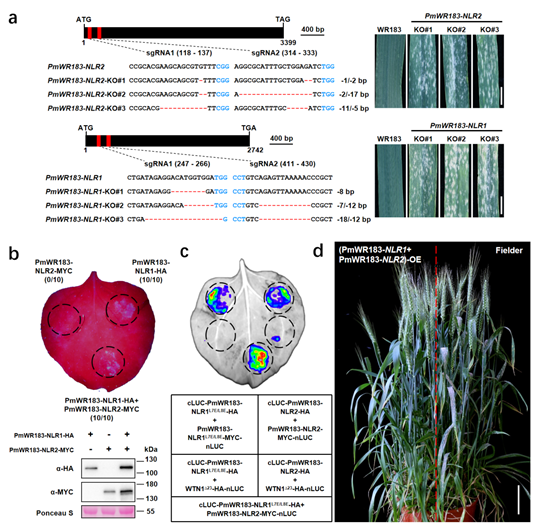Powdery mildew, caused by Blumeria graminis f. sp. tritici, is a major threat to global wheat production. A research team led by Prof. LIU Zhiyong at the Institute of Genetics and Developmental Biology, Chinese Academy of Sciences, has identified a novel resistance locus (PmWR183) from wild emmer wheat conferring resistance to powdery mildew in common wheat at the adult plant stage, revealing a previously unrecognized mechanism of cooperative immunity in wheat.
These findings were recently published in Nature Communications (https://doi.org/10.1038/s41467-025-64049-y).
PmWR183 encodes two closely linked nucleotide-binding leucine-rich repeat (NLR) proteins, PmWR183-NLR1 and PmWR183-NLR2, which function only as a pair. Transgenic wheat carrying both genes exhibited strong resistance to powdery mildew, whereas plants expressing either gene alone remained susceptible. Conversely, CRISPR/Cas9-mediated knockout of either gene abolished resistance, confirming their coordinated function.
Notably, the resistance is developmentally stage regulated: seedlings appear susceptibility, whereas adult plants display robust defense, suggesting a finely tuned temporal control of immune activation. Protein interaction assays further demonstrated that PmWR183-NLR1 and PmWR183-NLR2 physically associate even in the absence of pathogen challenge, offering mechanistic insight into their cooperative activity.
Population genomic analyses revealed that this NLR pair is rare in modern wheat but harbors extensive allelic diversity in wild emmer populations, indicating its natural evolutionary origin and probable loss during polyploidization and domestication. The researchers also developed molecular markers to enable its deployment in breeding programs.
“These findings define a new paradigm of paired NLR-mediated adult plant immunity and offer valuable genetic resources for developing wheat varieties with durable powdery mildew resistance,” said Dr. LIU. This research will advance the resilience of global wheat production.”

Figure. Functional verification and mechanism analysis of the powdery mildew resistance gene PmWR183 (Image by IGDB)
Contact:
Prof. LIU Zhiyong
Institute of Genetics and Developmental Biology, Chinese Academy of Sciences
Email: zyliu@genetics.ac.cn
 Contact:Prof. LIU ZhiyongInstitute of Genetics and Developmental Biology, Chinese Academy of SciencesEmail: zyliu@genetics.ac.cn
Contact:Prof. LIU ZhiyongInstitute of Genetics and Developmental Biology, Chinese Academy of SciencesEmail: zyliu@genetics.ac.cn CAS
CAS
 中文
中文




.png)
